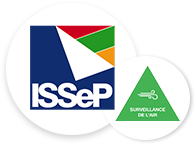Ambient air quality monitoring networks in Wallonia
Ambient air quality monitoring networks can typically be classified into three categories: telemetry networks, non-telemetry networks, and mobile networks.
Real-time network
This continuously measures various pollutants using benchmark analysers located in twenty-four stations (in 2019) spread over the entire territory of Wallonia. The pollutants measured are as follows: sulphur dioxide, nitric oxide and dioxide, carbon monoxide, ozone, gaseous mercury, "black carbon", and particulate matter (PM10 and PM2.5). This network also records meteorological parameters, such as wind speed and direction, temperature, pressure, relative humidity, and amount of precipitation.
Deferred networks
These networks study, on the basis of samples taken in situ and analyses carried out in the laboratory, various pollutants, such as black smoke, volatile organic compounds and polycyclic aromatic hydrocarbons, sedimentable dust, heavy metals in particulate matter, fluorides (particulate and gaseous), mercury, and wet fallout.
Cellular network
This network is intended to measure pollution in areas that have not been studied very much, or that present pollution that one wishes to better characterise, both in terms of the pollutants emitted and in terms of their spatial distribution. It brings together the sampling and analysis techniques of the two other networks mentioned above.
To find out more: www.issep.be/qualite-de-lair/ or visit our YouTube channel ISSEP WEB TV







